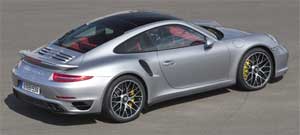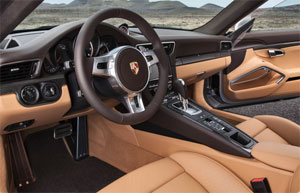2014 Porsche 911 Turbo S
2014 marks the 50th anniversary of the porsche 911. and despite being a pentagenarian, the 911 is showing no signs of slowing down. in fact, now that a turbo 991 has arrived it’s moving along quicker than ever. so come along as we hit our favorite road course, savannah’s roebling road raceway, to find out just how much faster and better this all-new 911 turbo really is!
While we are always pumped to drive a new Porsche, just as a race team begins thinking about their next race as soon as the checkered flag drops, we begin dreaming about the next Porsche we get to drive as soon as we hop out of one. So, no sooner did we pull our 911 C4S into pit lane at Roebling Road Raceway last year, we began thinking about this car, the 2014 Porsche 911 Turbo S.
The 911 Turbo and this 2-mile road course are made for each other. Unlike previous gens of Turbo, with the 991-series, both Turbo and Turbo S models are available right away, with the S adding more standard equipment and more power from the 3.8-liter twin-turbo flat-6.
Turbo numbers are 520-horsepower and 487 lb-ft. of torque. The Turbo S hikes those to 560 and 516, with up to 553 lb-ft. of torque available at full throttle, with overboost as part of the Sport Chrono package.
If there’s one constant in our society, no matter how much you give, people always seem to want more, and the new Turbo delivers. How much more? Well, the Turbo S is the quickest road going production Porsche ever. On Roebling’s front straight, we managed to hit 60 in 2.9-seconds, with the ¼-mile pass taking 10.8 at 129 miles-per-hour.
 And as great as that is, the real reason you should want a Turbo is for the handling. It’s all-wheel-drive of course, and the current system is a evolution of the torque vectoring setup with an added Electro-hydraulic control for the multi-plate coupling that enables more power to be delivered to the front axle faster.
And as great as that is, the real reason you should want a Turbo is for the handling. It’s all-wheel-drive of course, and the current system is a evolution of the torque vectoring setup with an added Electro-hydraulic control for the multi-plate coupling that enables more power to be delivered to the front axle faster.
In addition, the Turbo gains rear wheel steer. With an electromechanical actuator for each back wheel, the system provides varying degrees of steering to both tighten turns and increase high speed stability.
But even with electronics managing just about every aspect of the chassis, the drive experience is about as intuitive and easy as it can be. Amazingly enough, Porsche has succeeded in not entirely dialing out all of the driving enjoyment. But if you’re looking for hairball, rear end out kicks, you might have to wait a few more months for the GT3. This car has phenomenal grip. The harder you push it through corners, the more it eggs you on.
Active roll compensation keeps things flat no matter the speed, and the stability and overall manner through high speed sweepers is incredible. Roebling also has a few tight corners and when coming off of them, depending on how much throttle you were able to maintain, you will experience some turbo lag going full off to full on.
We like big brakes and we cannot lie, the Turbo’s standard ceramic brakes are eye popping effective. As for transmission, the Turbo is PDK only, and while purists will surely cry for a manual, we’re beyond that. The PDK’s shifts are incredibly quick, and it makes street driving in every day traffic that much more livable.
Who would have thought you’d need to artificially pump exhaust sound into the 911 to get the full experience, more so, who would have thought we’d enjoy it so much!
 Visually, all the usual Turbo clues are here, wider hips, enlarged air intakes, and serious 20-inch wheels. While new active air elements like an extending front spoiler and a slotted rear wing take down force to new levels. Full LED headlights provide bright-as- day nighttime illumination on the Turbo S.
Visually, all the usual Turbo clues are here, wider hips, enlarged air intakes, and serious 20-inch wheels. While new active air elements like an extending front spoiler and a slotted rear wing take down force to new levels. Full LED headlights provide bright-as- day nighttime illumination on the Turbo S.
There’s plenty for the tactile senses to enjoy inside as well, from the 2-tone leather treatment throughout to the Turbo specific gauge package.
Government Fuel Economy Ratings are also improved to 17-City, 24-Highway, and 20-Combined. That also improves the Energy Impact Score to 16.5-barrels of oil and 7.4 tons of CO2 emitted annually.
As for pricing, does it really matter? While every red-blooded driver should want a Turbo, you either can afford one or you can’t. Sticker shock starts at $149,250; Turbo S at $181,950.
It is truly insane that Porsche has taken the rear engine platform to this level. The 2014 Porsche 911 Turbo simply exceeds all rational expectations. Can you have too much of a good thing? As far as we’re concerned, never. And you can be assured that Porsche engineers are already working on delivering even more for the next one. And yes, we are already thinking about driving it!
Specifications
- Engine: 3.8-liter
- Horsepower: 560
- Torque: 516 lb-ft.
- 0-60 mph: 2.9-seconds
- 1/4 mile: 10.8 seconds @ 129 mph
- EPA: 17 mpg city/ 24 mpg highway
- Energy Impact: 16.5 barrels of oil/yr
- CO2 Emissions: 7.4 tons/yr
2024 Polestar 2
More Range And More Power For The Polestar 2
Volvo is well on their way to making the transition to an all-electric brand, but their sister-brand Polestar is already there. Now, we’ve spent lots of time in their all-wheel drive, five-door Polestar 2, having tested it in 2021, and a year later when a two-wheel drive version arrived. But, EV updates are coming quickly. So, let us be your guide for all that’s new with the Polestar 2.
While we are driving more EVs than ever, we’ve also been spending a lot of time recently circling back to ones we’ve previously tested. As in this new era of electrified vehicles, significant updates are arriving quickly, with R&D investments increasing and retrofitting them easier than ever. This is often done through software updates that can even be accomplished over the air. For 2024, the Polestar 2 has indeed gotten some software updates, but some physical ones as well.
Clearly aimed directly at Tesla’s Model 3 when it arrived; the Polestar 2’s build quality was vastly better, but range definitely came up short. So, addressing that was priority No. 1; and for ’24 the Polestar can travel up to 20% farther than before while consuming 9% less energy, and when it comes time to charge it back up, it can do that 34% faster too.
Range in the Single Motor version increases from a max of 270 to 320 miles thanks to a larger 82-kWh battery pack, and that solitary motor now powers the rear wheels, not the front wheels. It’s also bigger, coming in at 220 kW compared to the previous 170 kW front-wheel drive version, going from 231 to 299 horsepower.
Dual Motors keep the same 78-kWh battery, but still sees a boost from 260 to 276 miles and takes advantage of the larger rear motor for a new combined 310-kW output with 421 horsepower. Our test car has the added Performance Pack, which uses an additional 35 kW to deliver 455 horsepower and 546 lb-ft of torque, though max range drops to just 247 miles.
The new battery in rear-drive 2s will also charge faster, now accepting up to 205 kW for an 80% charge in 20 minutes; max for dual-motors stays at 155 kW, which puts an 80% charge at 34 minutes. Using 32 kWh of electricity per 100 miles, the Dual Motor earns a good efficiency rating.
The [Polestar] 2 has always been one of the most enjoyable EVs to drive, even more so now with that additional power coming from the rear motor.
Unfortunately, extremely cold temperatures kept us from seeing that increased range, as we were only on pace for about 194 miles in our test.
The 2 has always been one of the most enjoyable EVs to drive, even more so now with that additional power coming from the rear motor. And especially when equipped with the Performance Pack as it not only includes more power, but adds 20-inch forged wheels, upgraded brakes, and adjustable Ohlins Dual Flow Valve performance dampers. It greatly improves handling prowess without affecting ride quality, and is easily worth the $5,500 charge if you at all enjoy driving.
Even on a 20-degree track day there was plenty of grip through our handling course. No understeer or oversteer, and lots of feedback through the wheel. There was a nice, strong launch off the line that properly planted us firmly in the seat, and rocketed us to 60 in 4.5 seconds. Power delivery stayed pretty intense up until about 80 mph when there was a definite tapering off. Still, it was a 13.4-second quarter-mile at 102 mph; smooth, quiet, and stable the whole way.
When this car debuted, its Google-based infotainment setup was a novelty, but since then, more and more manufacturers are just “Googling it” so it doesn’t seem out of place at all. The wireless phone charger is easy to access, and there’s a great Harmon/Kardon sound system and panoramic sunroof to enhance the in-cabin experience. Exteriors have also been enhanced with a smooth grille insert and new wheel choices.
Hatchback practicality means 14.3 cu-ft of easy to access cargo space with split-folding seatbacks for longer items and expanding the space to 38.7 cu-ft. Plus, there’s even a sizeable storage bin up front under the hood.
Single Motor Polestar 2 pricing now starts at $51,300, with Dual Motors starting at $56,700; topping out at $64,400.
For a car manufacturer that hasn’t even been around for a decade yet, Polestar has kept itself busy, totally transforming their latest model in just a few years, making the 2024 Polestar 2 even more appealing. They are certainly off to a good start, and with a host of Polestars just over the horizon, including some all-important utility vehicles, this star will be shining even brighter.
Specifications
As Tested
- Motor Setup: Dual Motor
- Horsepower: 455
- 0-60 mph: 4.5 seconds
- EPA Range: 247 miles
- Efficiency : 32 kWh / 100 miles
- Battery Size: 78-kWh
- Torque: 546 lb-ft
- 1/4 Mile: 13.4 seconds at 102 mph
- MW Test Loop: ~ 194 miles
- Peak Charging Rate: 155 kW











































